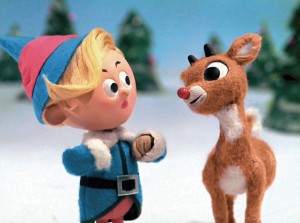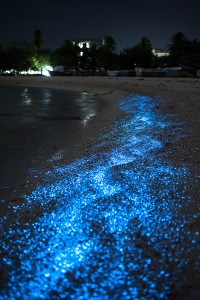By Michelle Engle

Some non-believers among you may say that Rudolph is nothing more than a fairy tale, that it’s impossible for a reindeer to have a glowing red nose. To those of you, I have this to say: it’s not magic, it’s science! Allow me to present evidence to support my hypothesis.
Fluorescent, or glowing, proteins are naturally produced by many different species. The most famous of these is perhaps the jellyfish, which scientists have utilized to engineer some fluorescent proteins in the lab. While scientists aren’t sure why jellyfish developed this ability to glow, they used the discovery of these fluorescent proteins in one of the first applications of genetic modification. This involved the insertion of the jellyfish protein (Green Fluorescent Protein, or GFP) into the genome of model organisms, such as E. coli. The use of fluorescent proteins in science has allowed us to visualize many different cellular processes, such as cell division, in real time under the microscope!

With recent advancements in gene editing technology, such as the invention of the CRISPR system, the ability to insert genes from one species into the genome of another species has become much simpler. One could imagine elves, decked out in the proper protective personal equipment, performing a quick reaction in the North Pole’s scientific laboratory to create a more festive reindeer.
However, Rudolph was first documented in 1939, way before this era of simple genetic manipulation. It’s possible that the scientific elves at the North Pole were way ahead of the human scientists, but let’s explore another possibility that could have led to the creation of Rudolph.
Animals like jellyfish are not the only organisms to produce fluorescent proteins – insects (e.g. fireflies), plankton, and even bacteria (e.g. Pyrodinium bahamense) have all been documented as bioluminescent (glowing) organisms. For example, Vieques, an island off the coast of Puerto Rico, is home to Mosquito Bay which is the largest bioluminescent bay in the world. Millions of Pyrodinium bahamense bacteria inhabit the waters of the bay and, when agitated, emit a glowing light for a fraction of a second (see picture below).

Bacteria have always been a part of mammalian development and it has recently been documented that humans and most other animals live together with many species of bacteria that together make up the microbiome. Moreover, each part of the body has its own established microbiome. So, the microbiome of the nose is very different from the microbiome of the small intestine. Scientists have also recently discovered that the microbiome can be changed by exposure to new microbes. What if Rudolph dipped his nose into Mosquito Bay for a quick drink while Santa was visiting some homes on Vieques? Rudolph’s nasal microbiome would have been exposed to the new, bioluminescent bacteria – which could have established itself and become a new, permanent resident of his nasal microbiome. The integration of Pyrodinium bahamense would cause his nose to glow, even after leaving Puerto Rico!
Therefore, it is scientifically possible for Rudolph to have a glowing nose. It’s not magic, it’s science!
For more information about gene editing and genetic modification, check out these links:
Breakthrough as gene-editing technique restores sight to blind animals – The Guardian
Gene editing shifts food possibilities forward – Popular Science
5 Reasons Gene Editing is Both Terrifying and Terrific – National Geographic
Edited by Temperance Rowell
